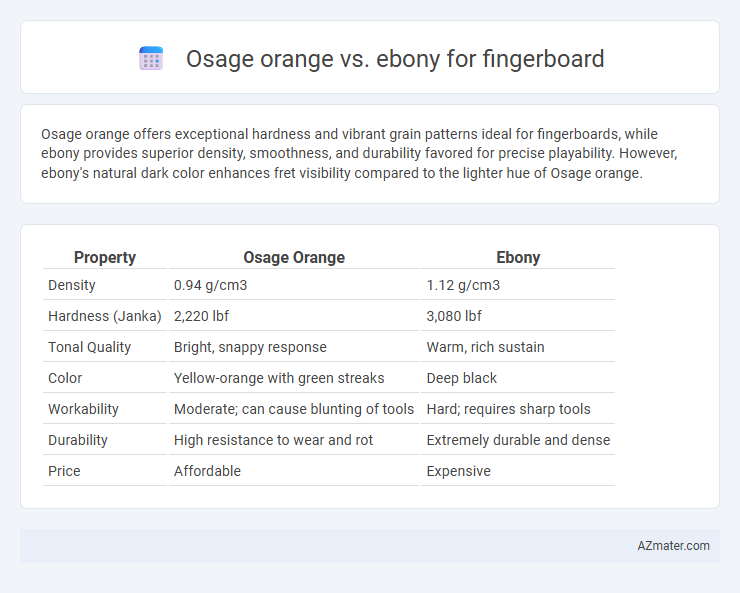Osage orange offers exceptional hardness and vibrant grain patterns ideal for fingerboards, while ebony provides superior density, smoothness, and durability favored for precise playability. However, ebony's natural dark color enhances fret visibility compared to the lighter hue of Osage orange.
Table of Comparison
| Property | Osage Orange | Ebony |
|---|---|---|
| Density | 0.94 g/cm3 | 1.12 g/cm3 |
| Hardness (Janka) | 2,220 lbf | 3,080 lbf |
| Tonal Quality | Bright, snappy response | Warm, rich sustain |
| Color | Yellow-orange with green streaks | Deep black |
| Workability | Moderate; can cause blunting of tools | Hard; requires sharp tools |
| Durability | High resistance to wear and rot | Extremely durable and dense |
| Price | Affordable | Expensive |
Introduction to Osage Orange and Ebony Fingerboards
Osage Orange fingerboards offer a unique alternative to traditional Ebony, known for their bright yellow hue and natural resistance to wear and moisture, making them a durable choice for stringed instruments. Ebony fingerboards, prized for their dense, smooth texture and deep black color, provide exceptional hardness and stability, favored by professional musicians for their fast playability and rich tonal response. Comparing Osage Orange and Ebony reveals distinct aesthetic and functional qualities, with Osage Orange providing a striking visual contrast and Ebony delivering classic performance and longevity.
Botanical Origins and Sources
Osage orange (Maclura pomifera) is a fast-growing, thorny tree native to the south-central United States, prized for its dense, bright yellow to orange wood with high strength and natural resistance to decay. Ebony refers to several species in the Diospyros genus, predominantly Diospyros ebenum from southern India and Sri Lanka, known for its dense, jet-black heartwood valued in high-end fingerboards for smoothness and durability. Both woods are sourced from distinct ecological zones, with Osage orange harvested primarily in North America and ebony imported from tropical Asian forests, impacting supply sustainability and cost.
Color and Visual Aesthetics
Osage orange fingerboards exhibit a vibrant yellow to greenish hue that deepens over time, providing a unique and striking contrast on guitars. Ebony, known for its rich, deep black color with occasional subtle brown streaks, offers a classic and elegant appearance prized by many luthiers. The visual aesthetics of Osage orange emphasize warmth and uniqueness, while ebony delivers a sleek, timeless look favored in traditional and high-end instruments.
Density and Hardness Comparison
Osage orange fingerboards feature a density of approximately 0.9 g/cm3, providing a balance of durability and workability, while ebony fingerboards boast higher density values around 1.0 to 1.2 g/cm3, contributing to exceptional hardness and resistance to wear. In hardness comparisons, ebony is significantly harder on the Janka scale, typically measuring between 3,080 to 3,300 lbf, compared to Osage orange's moderate hardness near 1,200 lbf, making ebony more resistant to dents and scratches under heavy playing conditions. These properties make ebony a preferred choice for players seeking maximum stability and longevity, whereas Osage orange offers a unique tonal character with slightly lighter weight and easier machinability.
Tonal Qualities and Sound Differences
Osage orange fingerboards produce a bright, articulate tone with pronounced midrange frequencies, offering clarity and snap ideal for cutting through a mix. Ebony fingerboards deliver a dense, smooth sound with deep lows and a balanced high-end, contributing to sustain and a warm complexity favored in jazz and blues genres. The hardness and tight grain of ebony enhance note definition and sustain, while osage orange provides a more resonant, lively attack with a slightly softer feel.
Durability and Longevity
Osage orange fingerboards are known for their exceptional hardness and resistance to wear, offering impressive durability comparable to traditional hardwoods. Ebony fingerboards, prized for their density and smooth surface, provide superior longevity and maintain tonal clarity even under heavy use. Both woods excel in withstanding string tension and frequent play, but ebony's natural oils contribute to a longer-lasting, low-maintenance fingerboard.
Workability for Luthiers
Osage orange offers luthiers exceptional workability due to its moderate density and natural resistance to wear, allowing for precise shaping and smooth finishing on fingerboards. Ebony, while significantly denser and harder, demands more effort and specialized tools to carve but provides superior durability and a sleek, polished surface ideal for high-end instruments. Both woods require attention to grain orientation for optimal fret installation, though Osage orange tends to be less brittle and more forgiving during intricate woodworking tasks.
Environmental Impact and Sustainability
Osage orange fingerboards derive from a fast-growing, invasive tree species that helps control ecological balance and reduces overreliance on endangered hardwoods, contributing to sustainable harvesting practices. Ebony, often sourced from slow-growing, tropical species, faces significant sustainability challenges due to overharvesting and habitat destruction, leading to strict regulations and limited availability. Choosing Osage orange supports environmentally responsible guitar construction by minimizing deforestation impacts and promoting the use of renewable resources.
Cost and Availability
Osage orange fingerboards are generally more affordable and easier to source due to the wood's wide availability in North America, making it a popular choice for budget-conscious musicians. Ebony, known for its dense, smooth texture and rich dark color, commands a higher price and can be harder to find because of limited supply and stricter harvesting regulations. Choosing between Osage orange and ebony often hinges on balancing cost efficiency against the desire for premium wood characteristics in fingerboard construction.
Which Fingerboard Material Should You Choose?
Choosing between Osage orange and ebony for a fingerboard depends on desired tone, durability, and aesthetic preferences. Ebony offers a dense, smooth surface with excellent sustain and a dark, polished appearance favored by many guitarists. Osage orange provides a unique yellow-orange hue, moderate hardness, and a slightly warmer tone but may require more maintenance due to its porosity compared to ebony's natural resistance to wear.

Infographic: Osage orange vs Ebony for Fingerboard
 azmater.com
azmater.com